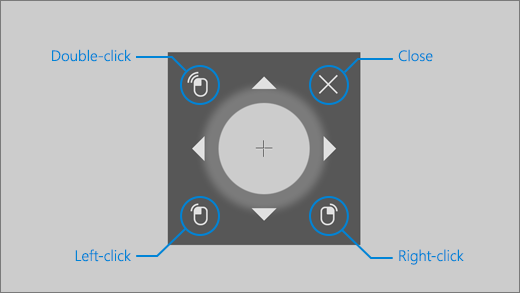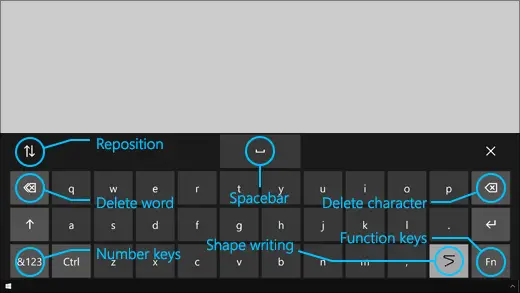Windows 11/10 houses an incredibly innovative feature—eye-tracking technology—which lets you control your mouse cursor, type using the on-screen keyboard, and also communicate with people using text-to-speech. Targeted towards audiences who need special assistance, this feature uses a special hardware-based camera to achieve this. In this guide, we will learn how to use Windows Eye Control in Windows 11/10.

What is Windows Eye Control?
People with challenges will now be able to access their Windows PC with the help of an Eye Tracker. Microsoft has recently announced the ‘Eye Control’ feature at the company’s hackathon. The feature is specifically designed for people with challenges to help them operate their Windows 11/10 PC with an on-screen keyboard and mouse.
The feature is specifically designed for Windows PC. In the first hackathon of Microsoft, the company announced this wonderful feature named Eye Control which can let the disabled users access the PC with their eyes control.
However, the feature also requires a compatible eye tracker to work. To use it, the users first need to turn on the Eye Control feature on the PC which then brings a Launchpad on the screen allowing users to get access to the PC. When the Launchpad appears on the screen, the users have to stare at the screen until the feature activates.
Once activated, the Eye Control feature lets users use the mouse from the Launchpad. You just need to position your eyes where you want the cursor to be. Similarly, they can select the on-screen keyboard from the Launchpad and just stare at the characters they want to type.
The company, however, states that this new feature might not work well in the sunlight and is still working to fix this issue. Also, it might not work when the users move the PC to a different lighting condition. Once moved, the tool might need a re-calibration. The company suggests restarting the tool in such a scenario.
The One Week Hackathon is focused on the company’s mission of empowering users worldwide. The commendable feature of Eye Control was inspired by another magical innovation Eye Gaze Wheelchair designed by the Ability Eye Gaze team. Eye Gaze Wheelchair which was the winning hack of 2014, is one of its kind where the user can operate and move the wheelchair with the movement of eyes.
This is certainly a revolutionary feature added in Windows and will be of great help to users with disabilities.
List of supported eye control devices:
This feature uses special hardware, and there are only a few compatible devices. It includes hardware from EyeTech and Tobii. While EyeTech lists only TM5 Mini, Tobii includes Eye Tracker 4C, EyeX, Dynavox PCEye Plus, EyeMobile Mini & Plus, PCEye Mini and Explore, and I-Series+.
The device tries to figure out where you are looking at the screen, and then turns into a mouse cursor. Next, as you move your eyes, it can figure out the changes.
Enable Eye Control in Windows 11/10
Eye Control can be enabled by going to Settings > Ease of Access > Eye control and selecting Turn on eye control. In Windows 11, you need to go to Settings > Accessibility > Eye Control > Toggle on. This will open LaunchPad which is like a control panel from where you can perform various functions like right-click, left-click, task view, and more.

How to control the mouse using Eye Control

- First, Dwell to look at the Precise mouse button on the launchpad.
- Then look at the screen where you want the mouse cursor to be placed.
- Once the cursor is at the right place, you can then select the mouse actions.
- You can do the same in reverse to select the options from the right or left-click.
- When you look off the screen, the action is canceled.
How to scroll/zoom through web pages and apps using Eye Control
To scroll, you need to dwell on the Scroll button on the launchpad. Once activated, when you look down, and up it scrolls accordingly. You can scroll left or right in the same way. This part is a little tricky though. The longer you dwell on any of these buttons, the more quickly you’ll scroll. So when you need to stop, look off-screen
How to Type using Eye Control keyboard
Following the same process again, dwell on the keyboard button on the launchpad, then dwell on the characters you want to type. However, make sure to launch the software keyboard when using it. Text suggestions work best in this case so make sure to look at them to select it. As of now, Eye control only supports US English keyboard layout.
Eye Control also lets you do shape writing. It increases the speed compared to this method along with text prediction. You will need to dwell at the Shape writing toggle to turn it on.
How to Configure & change Eye control settings
This will take time to get used to, and Microsoft has offered just the right options to configure the dwell time for all of them. To change them, dwell on Eye control settings on the launchpad. You can change the following settings:
- Typing dwell time. Set the dwell time for letters, numbers, and symbols.
- General dwell time. Set the dwell time for function keys, word predictions, and mouse cursor controls.
- Shape writing. Turn shape writing on and off.
- Gaze cursor. Turn on a cursor that shows where your eyes are pointing when dwelling on eye control features like the launchpad.
Use Text to Speech with Eye Control
If you wish to read what is written on the screen, you can use the text to speech button on the launchpad. Dwell on the Text-to-speech button on the launchpad. Then use the keyboard to type sentences and select the Play button to have them read out loud. You can change them anytime you by dwelling on them.

That said, you might have to configure your Speech settings, especially the voice. Go to Start > Settings > Time & language > Speech and choose a voice from the menu under Text-to-speech.
Limitations of Eye Control:
The best results for Eye control show up when you are not in extreme conditions, including bright sunlight, as it cannot track your eye’s location. It also changes a bit when using glasses and eye color, eye size, or eye shape. Privacy enthusiasts should also know that as of now Microsoft doesn’t collect, store, or share eye-tracking information. Windows Eye Control is not supported in Windows 10 S.
Source: Microsoft.
Can I use Eye Control in any language?
Yes, it is possible to use it in any language, but two factors will limit you. The software is offered by a third party, and you need to use the US English keyboard to use the text in eye control.
Does Eye Control work when wearing glasses on in Sunlight?
Situations like reflection, interfering lights, and the features the Eye Control device offers, usage can be limited. Eye tracking works differently even for eye color, eye size and eye shape. The best approach would be to read the manual of the device and see what resolutions and feature it offers.
The eye tracking device doesn’t react to my eye movememnts
Look at the Eye control area and if you see an exclamation mark instead of eyes, then you need to click on it, and setup the display. It usually happens when eye tracking device has been moved and no longer aligns with the screen as before.
Leave a Reply